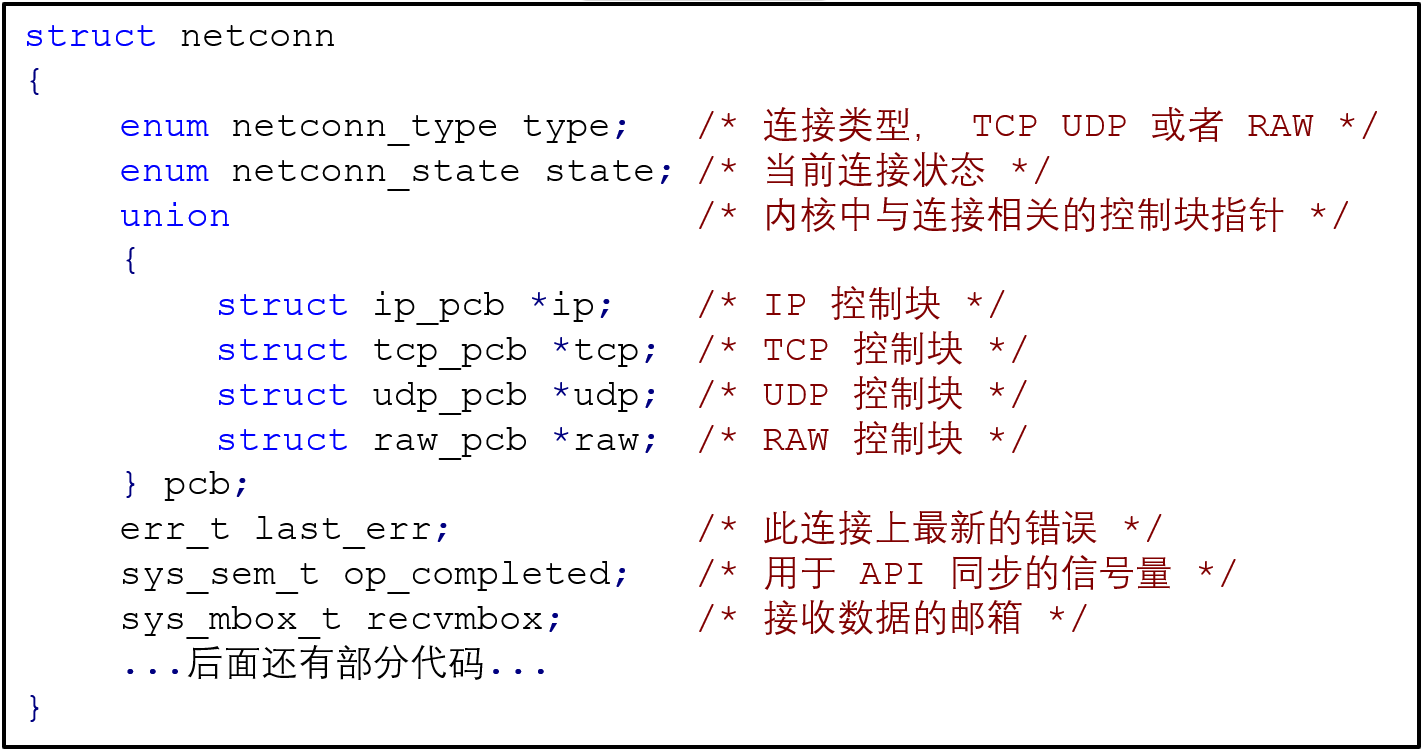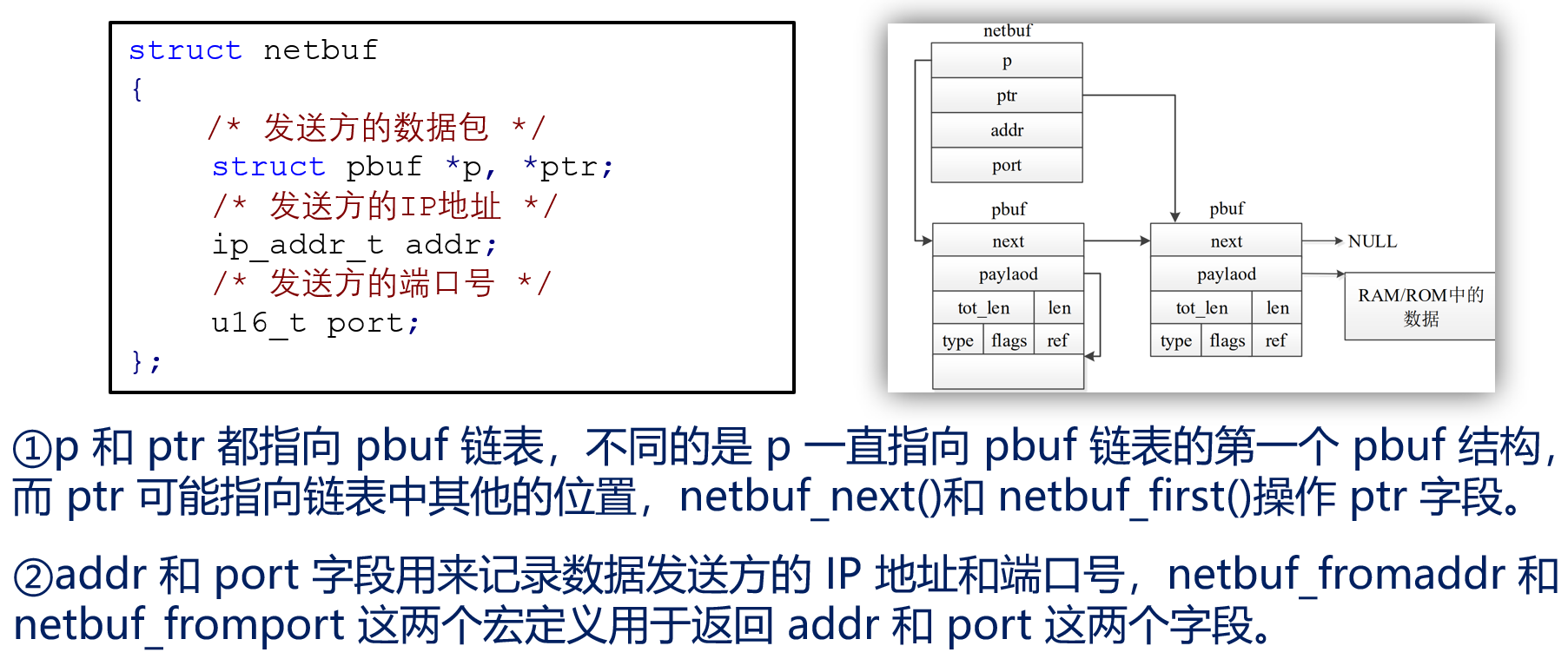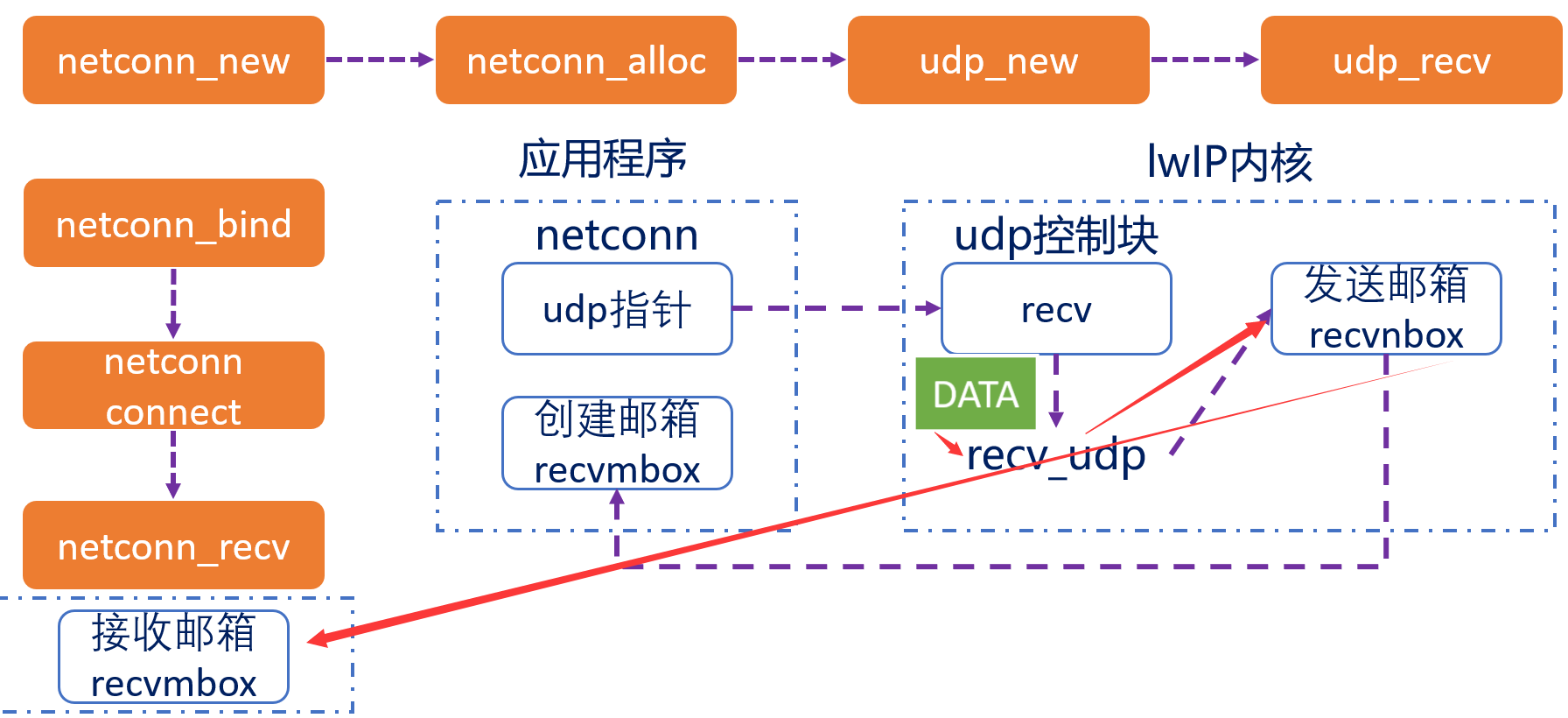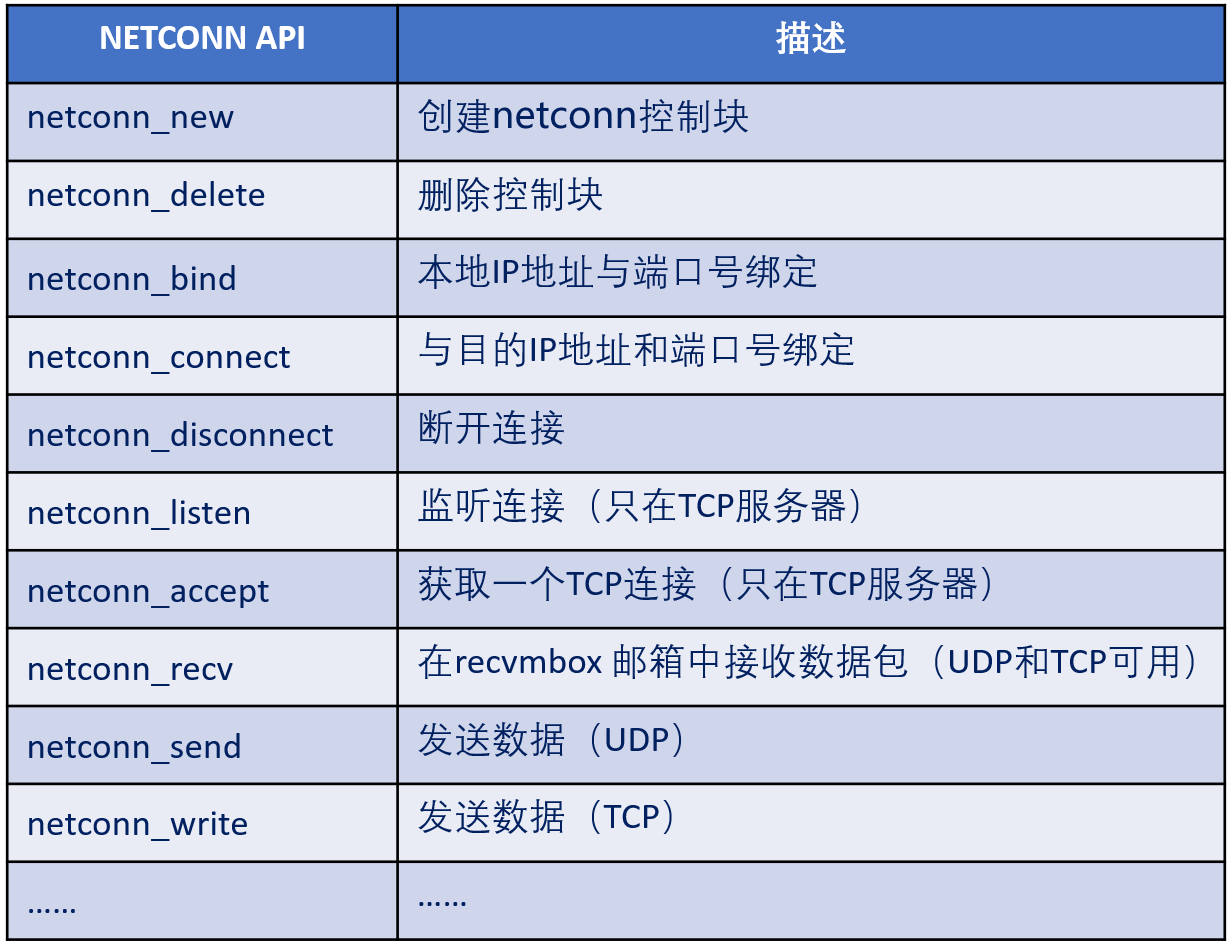Appearance
NETCONN
使用操作系统的IPC机制, 对网络连接进行抽象, 使用同一个接口实现UDP和TCP连接
实际是对RAW接口的封装, 或者直接调用底层的函数, 默认的时候是直接调用底层函数
数据类型

使用这一个结构体进行管理

使用这一个结构体进行管理数据
c
/**
* LWIP_SO_SNDTIMEO==1: Enable send timeout for sockets/netconns and
* SO_SNDTIMEO processing.
*/
#if !defined LWIP_SO_SNDTIMEO || defined __DOXYGEN__
#define LWIP_SO_SNDTIMEO 0
#endif
/**
* LWIP_SO_RCVTIMEO==1: Enable receive timeout for sockets/netconns and
* SO_RCVTIMEO processing.
*/
#if !defined LWIP_SO_RCVTIMEO || defined __DOXYGEN__
#define LWIP_SO_RCVTIMEO 1
#endif把这一个配置为1的时候, 发送以及接收有一个超时时间, 控制块里面有一个send_timeout, recv_timeout变量, 用于设置超时时间

API

连接
c
#define netconn_new(t) netconn_new_with_proto_and_callback(t, 0, NULL)
/**
* Create a new netconn (of a specific type) that has a callback function.
* The corresponding pcb is also created.
*
* @param t the type of 'connection' to create (@see enum netconn_type)
* @param proto the IP protocol for RAW IP pcbs
* @param callback a function to call on status changes (RX available, TX'ed)
* @return a newly allocated struct netconn or
* NULL on memory error
*/
struct netconn *
netconn_new_with_proto_and_callback(enum netconn_type t, u8_t proto, netconn_callback callback);建立了一个没有默认IP和状态改变回调函数的控制块
c/** @ingroup netconn_common * Protocol family and type of the netconn */ enum netconn_type { NETCONN_INVALID = 0, /** TCP IPv4 */ NETCONN_TCP = 0x10, /** UDP IPv4 */ NETCONN_UDP = 0x20, /** UDP IPv4 lite */ NETCONN_UDPLITE = 0x21, /** UDP IPv4 no checksum */ NETCONN_UDPNOCHKSUM = 0x22, /** Raw connection IPv4 */ NETCONN_RAW = 0x40 };
c
/**
* @ingroup netconn_common
* Close a netconn 'connection' and free its resources.
* UDP and RAW connection are completely closed, TCP pcbs might still be in a waitstate
* after this returns.
*
* @param conn the netconn to delete
* @return ERR_OK if the connection was deleted
*/
err_t
netconn_delete(struct netconn *conn)断开连接以及释放资源
c
/**
* @ingroup netconn_common
* Bind a netconn to a specific local IP address and port.
* Binding one netconn twice might not always be checked correctly!
*
* @param conn the netconn to bind
* @param addr the local IP address to bind the netconn to
* (use IP4_ADDR_ANY/IP6_ADDR_ANY to bind to all addresses)
* @param port the local port to bind the netconn to (not used for RAW)
* @return ERR_OK if bound, any other err_t on failure
*/
err_t
netconn_bind(struct netconn *conn, const ip_addr_t *addr, u16_t port)绑定本地的IP地址
c
/**
* @ingroup netconn_common
* Connect a netconn to a specific remote IP address and port.
*
* @param conn the netconn to connect
* @param addr the remote IP address to connect to
* @param port the remote port to connect to (no used for RAW)
* @return ERR_OK if connected, return value of tcp_/udp_/raw_connect otherwise
*/
err_t
netconn_connect(struct netconn *conn, const ip_addr_t *addr, u16_t port)建立连接
c
/**
* @ingroup netconn_udp
* Disconnect a netconn from its current peer (only valid for UDP netconns).
*
* @param conn the netconn to disconnect
* @return See @ref err_t
*/
err_t
netconn_disconnect(struct netconn *conn)断开连接
c
#define TCP_DEFAULT_LISTEN_BACKLOG 0xff
#define netconn_listen(conn) netconn_listen_with_backlog(conn, TCP_DEFAULT_LISTEN_BACKLOG)
/**
* @ingroup netconn_tcp
* Set a TCP netconn into listen mode
*
* @param conn the tcp netconn to set to listen mode
* @param backlog the listen backlog, only used if TCP_LISTEN_BACKLOG==1
* @return ERR_OK if the netconn was set to listen (UDP and RAW netconns
* don't return any error (yet?))
*/
err_t
netconn_listen_with_backlog(struct netconn *conn, u8_t backlog)c
/**
* @ingroup netconn_tcp
* Accept a new connection on a TCP listening netconn.
*
* @param conn the TCP listen netconn
* @param new_conn pointer where the new connection is stored
* @return ERR_OK if a new connection has been received or an error
* code otherwise
*/
err_t
netconn_accept(struct netconn *conn, struct netconn **new_conn)获取一个TCP连接
数据
c
/**
* @ingroup netconn_common
* Receive data (in form of a netbuf containing a packet buffer) from a netconn
*
* @param conn the netconn from which to receive data
* @param new_buf pointer where a new netbuf is stored when received data
* @return ERR_OK if data has been received, an error code otherwise (timeout,
* memory error or another error)
*/
err_t
netconn_recv(struct netconn *conn, struct netbuf **new_buf)获取数据, 获取的数据是一个netbuf类型的数据
c
/**
* @ingroup netconn_udp
* Send data over a UDP or RAW netconn (that is already connected).
*
* @param conn the UDP or RAW netconn over which to send data
* @param buf a netbuf containing the data to send
* @return ERR_OK if data was sent, any other err_t on error
*/
err_t
netconn_send(struct netconn *conn, struct netbuf *buf)发送UDP数据
c
#define netconn_write(conn, dataptr, size, apiflags) \
netconn_write_partly(conn, dataptr, size, apiflags, NULL)
/**
* @ingroup netconn_tcp
* Send data over a TCP netconn.
*
* @param conn the TCP netconn over which to send data
* @param dataptr pointer to the application buffer that contains the data to send
* @param size size of the application data to send
* @param apiflags combination of following flags :
* - NETCONN_COPY: data will be copied into memory belonging to the stack
* - NETCONN_MORE: for TCP connection, PSH flag will be set on last segment sent
* - NETCONN_DONTBLOCK: only write the data if all data can be written at once
* @param bytes_written pointer to a location that receives the number of written bytes
* @return ERR_OK if data was sent, any other err_t on error
*/
err_t
netconn_write_partly(struct netconn *conn, const void *dataptr, size_t size,
u8_t apiflags, size_t *bytes_written)发送TCP数据
数据块
c
/**
* @ingroup netbuf
* Create (allocate) and initialize a new netbuf.
* The netbuf doesn't yet contain a packet buffer!
*
* @return a pointer to a new netbuf
* NULL on lack of memory
*/
struct
netbuf *netbuf_new(void)获取一个数据控制块
c
/**
* @ingroup netbuf
* Allocate memory for a packet buffer for a given netbuf.
*
* @param buf the netbuf for which to allocate a packet buffer
* @param size the size of the packet buffer to allocate
* @return pointer to the allocated memory
* NULL if no memory could be allocated
*/
void *
netbuf_alloc(struct netbuf *buf, u16_t size)申请数据区域
c
/**
* Get the local or remote IP address and port of a netconn.
* For RAW netconns, this returns the protocol instead of a port!
*
* @param conn the netconn to query
* @param addr a pointer to which to save the IP address
* @param port a pointer to which to save the port (or protocol for RAW)
* @param local 1 to get the local IP address, 0 to get the remote one
* @return ERR_CONN for invalid connections
* ERR_OK if the information was retrieved
*/
err_t
netconn_getaddr(struct netconn *conn, ip_addr_t *addr, u16_t *port, u8_t local)获取本地或对方的IP地址和端口号
解析域名
c
/**
* @ingroup netconn_common
* Execute a DNS query, only one IP address is returned
*
* @param name a string representation of the DNS host name to query
* @param addr a preallocated ip_addr_t where to store the resolved IP address
* @param dns_addrtype IP address type (IPv4 / IPv6)
* @return ERR_OK: resolving succeeded
* ERR_MEM: memory error, try again later
* ERR_ARG: dns client not initialized or invalid hostname
* ERR_VAL: dns server response was invalid
*/
err_t netconn_gethostbyname(const char *name, ip_addr_t *addr)解析域名
UDP
- 使用netconn_new创建一个控制块
- 定义时间超时函数
- 使用netconn_bind绑定本地的IP和端口
- 使用netconn_connect建立连接
c
void lwip_demo(void)
{
err_t err;
static struct netconn *udpconn;
static struct netbuf *recvbuf;
static struct netbuf *sentbuf;
ip_addr_t destipaddr;
uint32_t data_len = 0;
struct pbuf *q;
BaseType_t lwip_err;
/* 第一步:创建udp控制块 */
udpconn = netconn_new(NETCONN_UDP);
/* 定义接收超时时间 */
udpconn->recv_timeout = 10;
if (udpconn != NULL) /* 判断创建控制块释放成功 */
{
/* 第二步:绑定控制块、本地IP和端口 */
err = netconn_bind(udpconn, IP_ADDR_ANY, LWIP_DEMO_PORT);
/*构造目的IP地址 */
IP4_ADDR(&destipaddr, DEST_IP_ADDR0,DEST_IP_ADDR1,DEST_IP_ADDR2,DEST_IP_ADDR3);
/* 第三步:连接或者建立对话框 */
netconn_connect(udpconn, &destipaddr, LWIP_DEMO_PORT); /* 连接到远端主机 */
if (err == ERR_OK) /* 绑定完成 */
{
while (1)
{
/* 第四步:如果指定的按键按下时,会发送信息 */
if ((g_lwip_send_flag & LWIP_SEND_DATA) == LWIP_SEND_DATA)
{
sentbuf = netbuf_new();
netbuf_alloc(sentbuf, strlen((char *)g_lwip_demo_sendbuf));
memcpy(sentbuf->p->payload, (void *)g_lwip_demo_sendbuf, strlen((char *)g_lwip_demo_sendbuf));
err = netconn_send(udpconn, sentbuf); /* 将netbuf中的数据发送出去 */
if (err != ERR_OK)
{
printf("发送失败\r\n");
netbuf_delete(sentbuf); /* 删除buf */
}
g_lwip_send_flag &= ~LWIP_SEND_DATA; /* 清除数据发送标志 */
netbuf_delete(sentbuf); /* 删除buf */
}
/* 第五步:接收数据 */
netconn_recv(udpconn, &recvbuf);
if (recvbuf != NULL) /* 接收到数据 */
{
memset(g_lwip_demo_recvbuf, 0, LWIP_DEMO_RX_BUFSIZE); /* 数据接收缓冲区清零 */
for (q = recvbuf->p; q != NULL; q = q->next) /* 遍历完整个pbuf链表 */
{
/* 判断要拷贝到UDP_DEMO_RX_BUFSIZE中的数据是否大于UDP_DEMO_RX_BUFSIZE的剩余空间,如果大于 */
/* 的话就只拷贝UDP_DEMO_RX_BUFSIZE中剩余长度的数据,否则的话就拷贝所有的数据 */
if (q->len > (LWIP_DEMO_RX_BUFSIZE - data_len)) memcpy(g_lwip_demo_recvbuf + data_len, q->payload, (LWIP_DEMO_RX_BUFSIZE - data_len)); /* 拷贝数据 */
else memcpy(g_lwip_demo_recvbuf + data_len, q->payload, q->len);
data_len += q->len;
if (data_len > LWIP_DEMO_RX_BUFSIZE) break; /* 超出TCP客户端接收数组,跳出 */
}
data_len = 0; /* 复制完成后data_len要清零 */
//获取的数据在另一个任务里面进行处理
lwip_err = xQueueSend(g_display_queue,&g_lwip_demo_recvbuf,0);
if (lwip_err == errQUEUE_FULL)
{
printf("队列Key_Queue已满,数据发送失败!\r\n");
}
netbuf_delete(recvbuf); /* 删除buf */
}
else vTaskDelay(5); /* 延时5ms */
vTaskDelay(10);
}
}
else printf("UDP绑定失败\r\n");
}
else printf("UDP连接创建失败\r\n");
}TCP
客户端
- 使用netconn_new获取一个控制块
- 使用函数netconn_connet连接服务器
- 使用netconn_getaddr获取本地的ip和端口
- 使用netconn_recv和netconn_write进行数据交流
c
/**
* @brief lwip_demo实验入口
* @param 无
* @retval 无
*/
void lwip_demo(void)
{
static struct netconn *tcp_clientconn = NULL; /* TCP CLIENT网络连接结构体 */
uint32_t data_len = 0;
struct pbuf *q;
err_t err,recv_err;
ip4_addr_t server_ipaddr,loca_ipaddr;
static uint16_t server_port,loca_port;
BaseType_t lwip_err;
char *tbuf;
server_port = LWIP_DEMO_PORT;
IP4_ADDR(&server_ipaddr,DEST_IP_ADDR0,DEST_IP_ADDR1,DEST_IP_ADDR2,DEST_IP_ADDR3); //构造目的IP地址
tbuf = mymalloc(SRAMIN, 200); /* 申请内存 */
sprintf((char *)tbuf, "Port:%d", LWIP_DEMO_PORT); /* 客户端端口号 */
lcd_show_string(5, 150, 200, 16, 16, tbuf, BLUE);
while (1)
{
tcp_clientconn = netconn_new(NETCONN_TCP);/* 创建一个TCP链接 */
err = netconn_connect(tcp_clientconn,&server_ipaddr,server_port);/* 连接服务器 */
if(err != ERR_OK)
{
printf("接连失败\r\n");
netconn_delete(tcp_clientconn);/* 返回值不等于ERR_OK,删除tcp_clientconn连接 */
}
else if (err == ERR_OK)/* 处理新连接的数据 */
{
struct netbuf *recvbuf;
tcp_clientconn->recv_timeout = 10;
netconn_getaddr(tcp_clientconn,&loca_ipaddr,&loca_port,1);/* 获取本地IP主机IP地址和端口号 */
printf("连接上服务器%d.%d.%d.%d,本机端口号为:%d\r\n",DEST_IP_ADDR0,DEST_IP_ADDR1, DEST_IP_ADDR2,DEST_IP_ADDR3,loca_port);
lcd_show_string(5, 90, 200, 16, 16, "State:Connection Successful", BLUE);
while(1)
{
if((g_lwip_send_flag & LWIP_SEND_DATA) == LWIP_SEND_DATA)/* 有数据要发送 */
{
err = netconn_write(tcp_clientconn ,g_lwip_demo_sendbuf,strlen((char*)g_lwip_demo_sendbuf),NETCONN_COPY); /* 发送tcp_server_sentbuf中的数据 */
if(err != ERR_OK)
{
printf("发送失败\r\n");
}
g_lwip_send_flag &= ~LWIP_SEND_DATA;
}
if((recv_err = netconn_recv(tcp_clientconn,&recvbuf)) == ERR_OK)/* 接收到数据 */
{
taskENTER_CRITICAL(); /* 进入临界区 */
memset(g_lwip_demo_recvbuf,0,LWIP_DEMO_RX_BUFSIZE); /* 数据接收缓冲区清零 */
for(q = recvbuf->p;q != NULL;q = q->next) /* 遍历完整个pbuf链表 */
{
/* 判断要拷贝到TCP_CLIENT_RX_BUFSIZE中的数据是否大于TCP_CLIENT_RX_BUFSIZE的剩余空间,如果大于 */
/* 的话就只拷贝TCP_CLIENT_RX_BUFSIZE中剩余长度的数据,否则的话就拷贝所有的数据 */
if(q->len > (LWIP_DEMO_RX_BUFSIZE - data_len))
{
memcpy(g_lwip_demo_recvbuf + data_len,q->payload,(LWIP_DEMO_RX_BUFSIZE - data_len));/* 拷贝数据 */
}
else
{
memcpy(g_lwip_demo_recvbuf + data_len,q->payload,q->len);
}
data_len += q->len;
if(data_len > LWIP_DEMO_RX_BUFSIZE)
{
break; /* 超出TCP客户端接收数组,跳出 */
}
}
taskEXIT_CRITICAL(); /* 退出临界区 */
data_len = 0; /* 复制完成后data_len要清零 */
lwip_err = xQueueSend(g_display_queue,&g_lwip_demo_recvbuf,0);
if (lwip_err == errQUEUE_FULL)
{
printf("队列Key_Queue已满,数据发送失败!\r\n");
}
netbuf_delete(recvbuf);
}
else if(recv_err == ERR_CLSD) /* 关闭连接 */
{
netconn_close(tcp_clientconn);
netconn_delete(tcp_clientconn);
printf("服务器%d.%d.%d.%d断开连接\r\n",DEST_IP_ADDR0,DEST_IP_ADDR1, DEST_IP_ADDR2,DEST_IP_ADDR3);
lcd_fill(5, 89, lcddev.width,110, WHITE);
lcd_show_string(5, 90, 200, 16, 16, "State:Disconnect", BLUE);
myfree(SRAMIN, tbuf);
break;
}
}
}
}
}服务器
- 调用函数netconn_new建立一个控制块
- 使用netconn_bind绑定TCP控制块, 本地的IP以及端口
- netconn_listen进入监听模式
- netconn_accept接收连接请求
- netconn_getaddr获取远端的IP以及端口
- netconn_write和recv进行数据的交流
c
/**
* @brief lwip_demo实验入口
* @param 无
* @retval 无
*/
void lwip_demo(void)
{
static struct netconn *tcp_serverconn = NULL; /* TCP SERVER网络连接结构体 */
uint32_t data_len = 0;
struct pbuf *q;
err_t err,recv_err;
uint8_t remot_addr[4];
struct netconn *newconn;
static ip_addr_t ipaddr;
static u16_t port;
BaseType_t lwip_err;
char *tbuf;
tbuf = mymalloc(SRAMIN, 200); /* 申请内存 */
sprintf((char *)tbuf, "Port:%d", LWIP_DEMO_PORT); /* 客户端端口号 */
lcd_show_string(5, 150, 200, 16, 16, tbuf, BLUE);
/* 第一步:创建一个TCP控制块 */
tcp_serverconn = netconn_new(NETCONN_TCP); /* 创建一个TCP链接 */
/* 第二步:绑定TCP控制块、本地IP地址和端口号 */
netconn_bind(tcp_serverconn,IP_ADDR_ANY,LWIP_DEMO_PORT); /* 绑定端口 8080号端口 */
/* 第三步:监听 */
netconn_listen(tcp_serverconn); /* 进入监听模式 */
tcp_serverconn->recv_timeout = 10; /* 禁止阻塞线程 等待10ms */
while (1)
{
/* 第四步:接收连接请求 */
err = netconn_accept(tcp_serverconn,&newconn); /* 接收连接请求 */
if(err == ERR_OK) newconn->recv_timeout = 10;
if (err == ERR_OK) /* 处理新连接的数据 */
{
struct netbuf *recvbuf;
netconn_getaddr(newconn,&ipaddr,&port,0); /* 获取远端IP地址和端口号 */
remot_addr[3] = (uint8_t)(ipaddr.addr >> 24);
remot_addr[2] = (uint8_t)(ipaddr.addr>> 16);
remot_addr[1] = (uint8_t)(ipaddr.addr >> 8);
remot_addr[0] = (uint8_t)(ipaddr.addr);
printf("主机%d.%d.%d.%d连接上服务器,主机端口号为:%d\r\n",remot_addr[0],
remot_addr[1],remot_addr[2],remot_addr[3],port);
lcd_show_string(5, 90, 200, 16, 16, "State:Connection Successful", BLUE);
while(1)
{
if((g_lwip_send_flag & LWIP_SEND_DATA) == LWIP_SEND_DATA) /* 有数据要发送 */
{
err = netconn_write(newconn ,
g_lwip_demo_sendbuf,strlen((char*)g_lwip_demo_sendbuf),NETCONN_COPY);
/* 发送g_lwip_demo_sendbuf中的数据 */
if(err != ERR_OK)
{
printf("发送失败\r\n");
}
g_lwip_send_flag &= ~LWIP_SEND_DATA;
}
if((recv_err = netconn_recv(newconn,&recvbuf)) == ERR_OK) /* 接收到数据 */
{
taskENTER_CRITICAL();/* 进入临界区 */
memset(g_lwip_demo_recvbuf,0,LWIP_DEMO_RX_BUFSIZE);/* 数据接收缓冲区清零 */
for(q = recvbuf->p;q != NULL;q = q->next) /* 遍历完整个pbuf链表 */
{
/* 判断要拷贝到LWIP_DEMO_RX_BUFSIZE中的数据是否大于LWIP_DEMO_RX_BUFSIZE
的剩余空间,如果大于 */
/* 的话就只拷贝LWIP_DEMO_RX_BUFSIZE中剩余长度的数据,否则的话就拷贝所有的数据 */
if(q->len > (LWIP_DEMO_RX_BUFSIZE-data_len))
{
memcpy(g_lwip_demo_recvbuf + data_len,q->payload,
(LWIP_DEMO_RX_BUFSIZE - data_len));/* 拷贝数据 */
}
else
{
memcpy(g_lwip_demo_recvbuf + data_len,q->payload,q->len);
}
data_len += q->len;
if(data_len > LWIP_DEMO_RX_BUFSIZE)
{
break; /*超出TCP客户端接收数组,跳出*/
}
}
taskEXIT_CRITICAL(); /* 退出临界区 */
data_len=0; /* 复制完成后data_len要清零 */
lwip_err = xQueueSend(g_display_queue,&g_lwip_demo_recvbuf,0);
if (lwip_err == errQUEUE_FULL)
{
printf("队列Key_Queue已满,数据发送失败!\r\n");
}
netbuf_delete(recvbuf);
}
else if(recv_err == ERR_CLSD) /* 关闭连接 */
{
netconn_close(newconn);
netconn_delete(newconn);
printf("主机:%d.%d.%d.%d断开与服务器的连接\r\n",remot_addr[0],
remot_addr[1],remot_addr[2],remot_addr[3]);
lcd_fill(5, 89, lcddev.width,110, WHITE);
lcd_show_string(5, 90, 200, 16, 16, "State:Disconnect", BLUE);
myfree(SRAMIN, tbuf);
break;
}
}
}
}
}